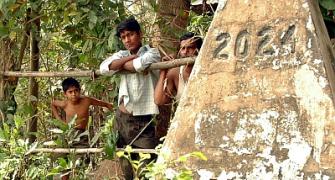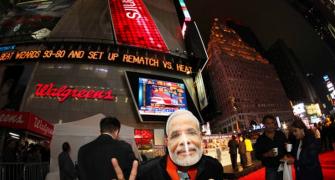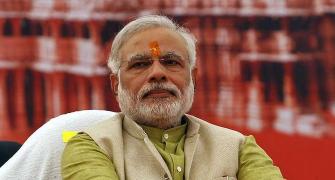 As India rises, creating niche areas for itself in the Asian landscape, China and India are bound to step on each other's vital areas of importance, says Srikanth Kondapalli.
As India rises, creating niche areas for itself in the Asian landscape, China and India are bound to step on each other's vital areas of importance, says Srikanth Kondapalli.
As the nation-wide polls indicate, the Bharatiya Janata Party is set to form the new government in New Delhi. Its prime ministerial candidate Narendra Modi had, during his tenure as chief minister of Gujarat and during the election campaign across India, provided an inkling into his foreign policy priorities.
Foremost in these speeches were mentions made about India's neighbours, with cross-border terrorism from Pakistan, migration from Bangladesh and China's 'mindset of expansionism' dominating the discourse.
As prime minister, Modi has the primary responsibility under the Constitution to protect the sovereignty and territorial integrity of India and further the wellbeing of citizens. Of all the countries, the case of China offers a mixed picture for Modi as on many fronts it has been a touch-and-go relationship.
First, the territorial dispute is still unresolved even after three decades of talks between officials and there is no indication to suggest that this issue will be resolved in the medium term.
If China's recent spurt in aggressive responses towards the Senkaku Islands with Japan, South China Sea islands with Southeast Asian countries, and the Depsang Plains incident in April 15 to May 6, 2013, is any indication, then this issue is likely to demand Modi's utmost attention. Given China's stiff response, his choices clearly remain the strengthening of conventional and nuclear deterrence.
Indeed, his BJP predecessor Atal Bihari Vajpayee was credited with precisely this posture in 1998.
Second, while China had revoked the 'stapled visas' explicitly issued since 2009, its role in Pakistan-controlled Kashmir is ever-growing. With the recent unveiling of the Silk Road Economic Belt passing through Gilgit and Baltistan, China had made definitive choices, regardless of India's sovereignty concerns.
On the other hand, India was surprised to hear from China's foreign ministry spokeswoman that India should not be 'concerned' about the disputed South China Sea islands.
Third, under the UPA government, there has been a logjam with China on the membership issue at the United Nations Security Council, the Nuclear Supplies Group and the Shanghai Cooperation Organisation, despite seeming progress between the two countries on climate change proposals, BRICS and the like.
Clearly, then, Modi needs to take a deep look at the progress so far of 'strategic partnership and cooperation' between the two countries since April 2005 and a zero-based assessment needs to be made.
Fourth, Modi had advocated, during the election campaigns, the developmental route to resolve India's problems and to usher in Indian rejuvenation. On this issue, however, while China had enhanced investments in India and has been exploring setting up industrial parks, cumulatively Beijing's direct investment is less than $460 million in India in a over a decade.
Although project related investments from China had shown substantial increase, direct investments have been minimal, despite China possessing over $3.8 trillion in reserves.
On the other hand, Japan, South Korea and Singapore have enhanced their investments in India without strings attached.
Modi then has clear priorities. His experience during the visits to Tokyo, Singapore and Beijing could come in handy in making a holistic assessment on this issue.
A related issue -- that of the widening bilateral trade deficit -- which accounts for about $167 billion in favour of China since 2007, also needs to be urgently addressed by the new prime minister given the fact that this deficit is contributing to more than half of the current account deficit of India.
Exploring market economy status in China, seeking more investments, strengthening manufacturing sector's role in the Indian economy are some options.
Fifth, given the enormous pressure that China had been exerting on India in the Indian Ocean region -- reflected in the 16 naval missions to the Gulf of Aden, taking over of Gwadhar port in Pakistan and eyeing Hambantota and Chittagong in the longer run -- as well as the formal suggestion to consider the Chinese-led maritime silk road, Modi need to re-assess the naval and maritime strategies even as China is bent on edging India out of the South China Sea.
Finally, and more significantly, a comprehensive assessment about the strategic rise of China -- which is poised to become the largest economy in the world possibly during Modi's tenure itself and the largest defence spender in Asia -- and its implications for India at the global and regional levels, needs to be made.
As India had been rising, creating niche areas for itself in the Asian landscape, China and India are bound to step on each other's vital areas of importance.
While the policy formulation of 'enough space in Asia' for both the simultaneously rising India and China deflected any direct clash between these two Asian countries, the landscape of the region itself is undergoing tectonic shifts.
This situation needs radical overhaul of the Indian assessments on China's rise and what is in store for India in the coming years and decades.
The previous government had expressed concerns on China's rise essentially in three areas -- anti-satellite tests, competition for resources in the third markets and China striving for a 'low-level equilibrium' in South Asia.
Currently, with a 'new-type of major power relations' between China and the United States strengthening and the G-2 process becoming a reality, India needs to clearly think about its priorities and partners at the regional and international levels.
Image: Narendra Modi with Yu Zhengsheng, member of the political bureau of the Communist Party of China Central Committee and secretary of the CPC Shanghai Committee, during his visit to the region in 2011 as part of his Beijing/Shanghai/Chengdu trip. Photograph: Consulate General of India in Shanghai.
Srikanth Kondapalli is Professor in Chinese Studies at Jawaharlal Nehru University.








